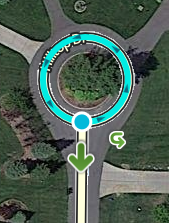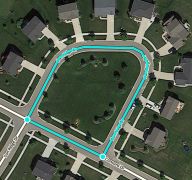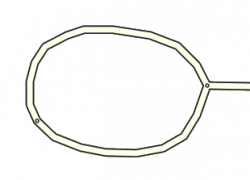Loops
-
U-shaped road
-
terminal or dead-end loop
-
roundabout or traffic circle
Road segments form a loop when you can trace a path from a starting point around to the same point without retracing any portion of the traced path.
Every loop must be made up of three or more segments

Any loop that does not follow this rule can cause problems for the Waze routing server. If there is no side-street, you must insert an extra junction node along the loop. Many new editors will see the extra junction node(s), assume they are not needed, and delete them. One way to prevent this is to add a driveway to the loop. Another solution is to educate new editors.
One-segment or dead-end loops

One-segment, self-connected, or dead-end loops are often found in basemap areas. Waze editors (other than waze staff) cannot create a one-segment loop.
Two-segment loops
Two-segment loops are also known as "same endpoint drivable segments" or "same
Loop save errors
The Waze Map Editor may be resistant in editing a loop that does not already follow the rule that it must be broken in two. If you run into saving errors, try one of the following approaches.
If the loop and the road leading to it have the same name:
- Select the loop and the road
- Click the bridge icon that appears (one end of the loop will disconnect from the other)
- Move the now free end of the loop so it is slightly separated
- Save
- Cut the loop
- Reconnect the disconnected end of the loop
- Confirm turns
If the loop and the road leading to it have different names:
- Draw a new road segment that connect to the loop/road junction
- Give that new road the same exact name as the loop
- Select the loop and the new road segment
- Click the bridge icon that appears (one end of the loop will disconnect from the other)
- Move the now free end of the loop so it is slightly separated
- Save
- Cut the loop
- Reconnect the disconnected end of the loop
- Confirm turns
Here is a video on YouTube showing the second method.


